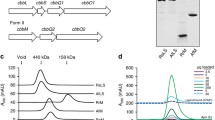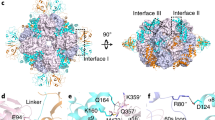Abstract
Rubisco catalyzes the first step reaction in the carbon fixation pathway, bonding atmospheric CO2/O2 to ribulose 1,5-bisphosphate; it is therefore considered one of the most important enzymes in the biosphere. Genetic modifications to increase the carboxylase activity of rubisco are a subject of great interest to agronomy and biotechnology, since this could increase the productivity of biomass in plants, algae and cyanobacteria and give better yields in crops and biofuel production. Thus, the aim of this study was to characterize in silico the catalytic domain of the rubisco large subunit (rbcL gene) of Cyanobium sp. CACIAM14, and identify target sites to improve enzyme affinity for ribulose 1,5-bisphosphate. A three-dimensional model was built using MODELLER 9.14, molecular dynamics was used to generate a 100 ns trajectory by AMBER12, and the binding free energy was calculated using MM-PBSA, MM-GBSA and SIE methods with alanine scanning. The model obtained showed characteristics of form-I rubisco, with 15 beta sheets and 19 alpha helices, and maintained the highly conserved catalytic site encompassing residues Lys175, Lys177, Lys201, Asp203, and Glu204. The binding free energy of the enzyme–substrate complexation of Cyanobium sp. CACIAM14 showed values around −10 kcal mol−1 using the SIE method. The most important residues for the interaction with ribulose 1,5-bisphosphate were Arg295 followed by Lys334. The generated model was successfully validated, remaining stable during the whole simulation, and demonstrated characteristics of enzymes with high carboxylase activity. The binding analysis revealed candidates for directed mutagenesis sites to improve rubisco’s affinity.







Similar content being viewed by others
References
Andersson I, Backlund A (2008) Structure and function of rubisco. Plant Physiol Biochem 46:275–291. doi:10.1016/j.plaphy.2008.01.001
Field B, Randerson F (1998) Primary production of the biosphere: integrating terrestrial and oceanic components. Science 281:237–240
Andersson I (2008) Catalysis and regulation in rubisco. J Exp Bot 59:1555–1568. doi:10.1093/jxb/ern091
Schneider G, Lindqvist Y, Brändén CI (1992) RUBISCO: structure and mechanism. Annu Rev Biophys Biomol Struct 21:119–143. doi:10.1146/annurev.bb.21.060192.001003
Lorimer GH, Miziorko HM (1980) Carbamate formation on the epsilon-amino group of a lysyl residue as the basis for the activation of ribulosebisphosphate carboxylase by CO2 and Mg2+. Biochemistry 19:5321–5328
Parry MA, Andralojc PJ, Mitchell RA et al (2003) Manipulation of Rubisco: the amount, activity, function and regulation. J Exp Bot 54:1321–1333
Lin MT, Occhialini A, Andralojc PJ et al (2014) A faster Rubisco with potential to increase photosynthesis in crops. Nature 513:547–550. doi:10.1038/nature13776
Torella JP, Gagliardi CJ, Chen JS et al (2015) Efficient solar-to-fuels production from a hybrid microbial–water-splitting catalyst system. Proc Natl Acad Sci USA 112:2337–2342. doi:10.1073/pnas.1424872112
Lima ARJ, Siqueira AS, Dos Santos BGS et al (2014) Draft genome sequence of the Brazilian Cyanobium sp. Strain CACIAM 14. Genome Announc 2:e00669-14. doi:10.1128/genomeA.00669-14
Aziz RK, Bartels D, Best AA et al (2008) The RAST Server: rapid annotations using subsystems technology. BMC Genomics 9:75. doi:10.1186/1471-2164-9-75
Altschul SF, Gish W, Miller W et al (1990) Basic local alignment search tool. J Mol Biol 215:403–410. doi:10.1016/S0022-2836(05)80360-2
Robert X, Gouet P (2014) Deciphering key features in protein structures with the new ENDscript server. Nucleic Acids Res 42:W320–324. doi:10.1093/nar/gku316
Thompson JD, Higgins DG, Gibson TJ (1994) CLUSTAL W: improving the sensitivity of progressive multiple sequence alignment through sequence weighting, position-specific gap penalties and weight matrix choice. Nucleic Acids Res 22:4673–4680
Martí-Renom MA, Stuart AC, Fiser A et al (2000) Comparative protein structure modeling of genes and genomes. Annu Rev Biophys Biomol Struct 29:291–325. doi:10.1146/annurev.biophys.29.1.291
Chen VB, Arendall WB, Headd JJ et al (2010) MolProbity: all-atom structure validation for macromolecular crystallography. Acta Crystallogr D Biol Crystallogr 66:12–21. doi:10.1107/S0907444909042073
Bowie JU, Lüthy R, Eisenberg D (1991) A method to identify protein sequences that fold into a known three-dimensional structure. Science 253:164–170
Thomsen R, Christensen MH (2006) MolDock: a new technique for high-accuracy molecular docking. J Med Chem 49:3315–3321. doi:10.1021/jm051197e
Azevedo WFD (2010) MolDock applied to structure-based virtual screening. Curr Drug Targets 11:327–34
Case DA, Berryman JT, Betz RM, Cerutti DS, Cheatham TE III, Darden TA, Duke RE, Giese TJ, Gohlke H, Goetz AW, Homeyer N, Izadi S, Janowski P, Kaus J, Kovalenko A, Lee TS, LeGrand S, Li P, Luchko T, Luo R, Madej B, Merz KM, Monard G, Needham P, Nguyen H, Nguyen HT, Omelyan I, Onufriev A, Roe DR, Roitberg A, Salomon-Ferrer R, Simmerling CL, Smith W, Swails J, Walker RC, Wang J, Wolf RM, Wu X, York DM, Kollman PA (2015) AMBER 2015, University of California, San Francisco.
Izaguirre JA, Catarello DP, Wozniak JM, Skeel RD (2001) Langevin stabilization of molecular dynamics. J Chem Phys 114:2090–2098. doi:10.1063/1.1332996
Hou T, Wang J, Li Y, Wang W (2011) Assessing the performance of the MM/PBSA and MM/GBSA methods: I. The accuracy of binding free energy calculations based on molecular dynamics simulations. J Chem Inf Model 51:69–82. doi:10.1021/ci100275a
Hayes JM, Archontis G (2012) MM-GB(PB)SA calculations of protein-ligand binding free energies. In: Wang L (ed) Biochemistry, genetics and molecular biology: Molecular dynamics—studies of synthetic and biological macromolecules. Intech, http://www.intechopen.com/doi: 10.5772/37107
Sulea T, Cui Q, Purisima EO (2011) Solvated interaction energy (SIE) for scoring protein–ligand binding affinities. 2. Benchmark in the CSAR-2010 scoring exercise. J Chem Inf Model 51:2066–2081. doi:10.1021/ci2000242
Gutteridge S, Gatenby A (1995) Rubisco synthesis, assembly, mechanism, and regulation. Plant Cell 7:809–819
Parry MAJ, Andralojc PJ, Scales JC et al (2013) Rubisco activity and regulation as targets for crop improvement. J Exp Bot 64:717–730. doi:10.1093/jxb/ers336
Whitney SM, von Caemmerer S, Hudson GS, Andrews TJ (1999) Directed mutation of the rubisco large subunit of tobacco influences photorespiration and growth. Plant Physiol 121:579–588. doi:10.1104/pp.121.2.579
Duff AP, Andrews TJ, Curmi PM (2000) The transition between the open and closed states of rubisco is triggered by the inter-phosphate distance of the bound bisphosphate. J Mol Biol 298:903–916. doi:10.1006/jmbi.2000.3724
Whitney SM, Sharwood RE, Orr D et al (2011) Isoleucine 309 acts as a C4 catalytic switch that increases ribulose-1,5-bisphosphate carboxylase/oxygenase (rubisco) carboxylation rate in Flaveria. Proc Natl Acad Sci USA 108:14688–14693. doi:10.1073/pnas.1109503108
Gutteridge S, Rhoades DF, Herrmann C (1993) Site-specific mutations in a loop region of the C-terminal domain of the large subunit of ribulose bisphosphate carboxylase/oxygenase that influence substrate partitioning. J Biol Chem 268:7818–7824
Galmés J, Conesa MÀ, Díaz-Espejo A et al (2014) Rubisco catalytic properties optimized for present and future climatic conditions. Plant Sci 226:61–70. doi:10.1016/j.plantsci.2014.01.008
Acknowledgments
We would like to thank the Universidade Federal do Pará (Federal University of Para) for providing the computer systems, including the software licences needed to carry out this investigation; the Center for Technological Innovation for technical support and development of scripts; and the Fundação Amazônia de Amparo a Estudos e Pesquisas do Pará (FAPESPA) for financially supporting the project (process ICAAF 099/2014).
Author information
Authors and Affiliations
Corresponding authors
Rights and permissions
About this article
Cite this article
Siqueira, A.S., Lima, A.R.J., Dall’Agnol, L.T. et al. Comparative modeling and molecular dynamics suggest high carboxylase activity of the Cyanobium sp. CACIAM14 RbcL protein. J Mol Model 22, 68 (2016). https://doi.org/10.1007/s00894-016-2943-y
Received:
Accepted:
Published:
DOI: https://doi.org/10.1007/s00894-016-2943-y




